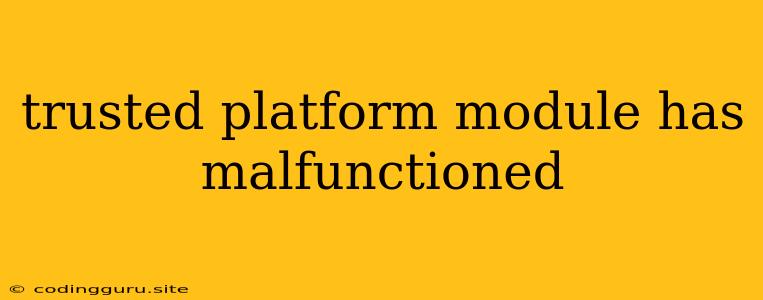What is a Trusted Platform Module (TPM)?
A Trusted Platform Module (TPM) is a specialized security chip embedded on your computer's motherboard. It's designed to provide a secure and isolated environment for sensitive cryptographic operations, such as encryption keys and digital signatures.
Think of the TPM as a digital vault within your computer. It holds and protects your digital assets, ensuring their integrity and authenticity.
Why Does the Error "Trusted Platform Module Has Malfunctioned" Occur?
The error message "Trusted Platform Module has malfunctioned" indicates a problem with your TPM chip. This could be due to various reasons, including:
- Hardware Failure: The TPM chip itself could be faulty or damaged, rendering it unable to function correctly.
- Driver Issues: Outdated or incompatible drivers for the TPM chip can cause conflicts and malfunctions.
- Software Conflicts: Certain software applications might interfere with the TPM's operation.
- BIOS Settings: Incorrect BIOS settings related to the TPM can lead to errors.
- Operating System Problems: Corrupted operating system files or settings might affect the TPM's functionality.
How to Troubleshoot the "Trusted Platform Module Has Malfunctioned" Error
Here's a step-by-step guide to resolving the "Trusted Platform Module has malfunctioned" error:
1. Check Your BIOS Settings
- Access BIOS: Restart your computer and press the appropriate key (often F2, Del, or Esc) to enter the BIOS setup menu.
- Locate TPM Settings: Navigate to the "Security" or "Advanced" section of your BIOS. Look for options related to the Trusted Platform Module (TPM), Security Device Support, or similar names.
- Enable TPM: Ensure that the TPM is enabled and configured correctly. If it's disabled, enable it. Make sure the TPM Security settings are appropriate for your needs.
- Save Changes: Once you've made the necessary adjustments, save the changes and exit the BIOS setup.
2. Update TPM Drivers
- Check for Updates: Search for and install the latest drivers for your Trusted Platform Module from your computer manufacturer's website or the chip manufacturer's website (e.g., Intel, AMD).
- Use Device Manager: Go to "Device Manager" (right-click the "Start" menu and choose "Device Manager"). Expand the "Security Devices" category.
- Update Drivers: Locate the TPM device and right-click it. Choose "Update Driver" and follow the instructions to install the latest drivers.
3. Run Hardware Diagnostic Tests
- Manufacturer Diagnostics: Your computer manufacturer might provide hardware diagnostic tools. Check their website or support documentation for details.
- Third-Party Utilities: Some third-party diagnostic tools, such as MemTest86+ (for memory testing) or the manufacturer's provided tools, can help pinpoint hardware issues.
4. Check for Software Conflicts
- Recent Changes: Consider any recent software installations or updates that might have coincided with the error. Try uninstalling or rolling back those changes.
- Security Software: Certain security software programs might interfere with the TPM. Temporarily disable your antivirus or firewall to see if the issue resolves.
5. Perform a Clean Boot
A clean boot helps identify potential software conflicts. This involves starting Windows with only essential drivers and services:
- Open System Configuration: Press "Windows Key + R" to open the "Run" dialog. Type "msconfig" and press "Enter."
- Disable Startup Items: In the "System Configuration" window, go to the "Startup" tab and deselect any non-essential startup items.
- Disable Services: Go to the "Services" tab, check the box for "Hide all Microsoft services," and then disable all remaining services.
- Restart Your Computer: Apply the changes and restart your computer.
- Identify the Issue: If the TPM error is gone, re-enable services and startup items one by one to identify the culprit.
6. Reinstall Windows (Last Resort)
If the issue persists despite trying the above steps, a clean Windows installation might be necessary. This will remove all software and drivers, potentially resolving the problem:
- Backup Your Data: Ensure you back up all essential files before proceeding.
- Create Installation Media: Download the Windows installation media from Microsoft's website.
- Perform a Clean Install: Follow the instructions on the installation media to perform a clean install of Windows.
Conclusion
The "Trusted Platform Module has malfunctioned" error can be frustrating. By systematically following these troubleshooting steps, you can identify the root cause and resolve the issue. Remember, if you suspect a hardware failure, contact your computer manufacturer or a qualified technician for assistance.
